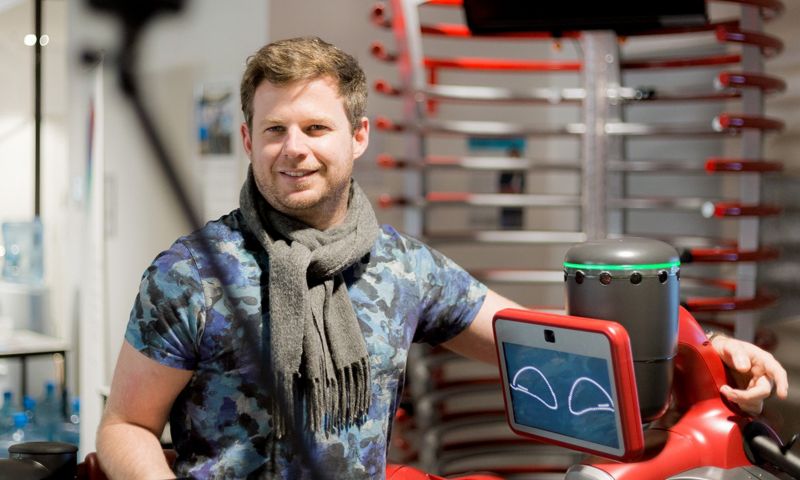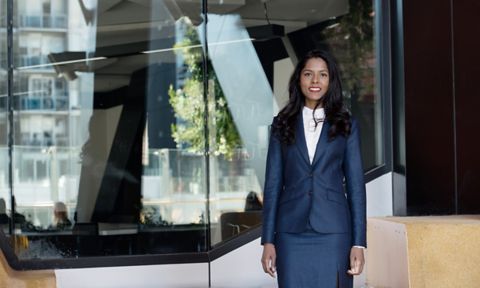Learning to code leads Leroy from the bush to big time robotics.

Building a career as a software developer and robotics expert doesn’t necessarily mean you spent your childhood glued to a computer screen.
Growing up in the Australian bush with few modern amenities, let alone a computer, Leroy Clunne-Kiely couldn’t have imagined a future in robotics and artificial intelligence, but a career-changing Master of Information Technology has him living the dream.
"I never thought that in two years I would transition from having zero ability to code, to writing and deploying software for various types of robots – that type of learning curve is difficult to come by," he said.
Living a more remote lifestyle than many Australians didn’t inhibit his curiosity about the wider world, especially technology.
"I was lucky enough to grow up on the east coast, in rural New South Wales, near a small hippy town called Bellingen, and spent my teenage years living essentially off-grid in a camp-site," he said.
"Technology was always of interest, though I didn’t have access to computing at home, which I think actually made me more interested, and it didn't prevent me having access to ideas about technology."
Engineering a new life
Inspired by science fiction and driven by a desire to put technology to use, Clunne-Kiely first studied engineering before finding work in San Francisco.
"Freelancing as an engineering project manager in San Francisco, I was finding that potential clients were doubting my capability to deliver technology projects, as I lacked a coding background," he said.
"So after returning to Australia I was determined to learn the codes and found myself at RMIT."
Learning new tricks of the trade
Learning coding was just the beginning, as studying for the Master of Information Technology also included hands-on projects with the latest software and robotics technologies.
"Every semester I felt that I could do new things that I didn’t know how to previously, eventually culminating in a capstone project with a crew of talented students, deploying code onto a humanoid robot for the Commonwealth Bank," he said.
"We integrated an end-to-end system that allowed a human to interact with the robot purely via natural language (normal speech) and have it autonomously navigate a space and provide guided tours, while responding verbally in a similar vein to a typical chat-bot (like Apple's Siri or Amazon's Alexa).
"Delivering a project like this really helped my credibility as an engineering technologist, as these days the conversation with clients is more attuned to 'What do we want?' as opposed to 'Are you really capable?'."
Towards new horizons
Working with industry allows you to hone your skills on a real-world project, but more than that, it gives you the experience of working with clients and can even lead to a job.
"We mostly worked on the Commonwealth project at RMIT's VXLab. And its director, Professor Heinz Schmidt, was so enthused he ended up offering me the chance to work under him," he said.
"I now have the pleasure of working on challenging ideas with high performance computing, providing support for some of our in-house robots, and occasionally I get to develop new functionality for other humanoid robots at RMIT, like our new pseudo-mascot Baxter.
"But whilst working for RMIT as a research software engineer, I'm also freelancing, providing bespoke technology solutions to clients in Australia and abroad, with both roles being direct carry-overs from my Masters project."
Real skills to fix real problems
Being able to apply what you learn in class to tackle real business challenges is what sets aside his experience at RMIT.
"As someone who loves to get their hands dirty building and creating, I can see that aspect is a mentality ingrained through RMIT’s strong ties to industry and its capacity to present real-world opportunities, besides the technical know-how of how to build, analyse and deploy software," he said.
"Doing a postgrad was the fastest way for me to deal with the career ceiling, and I now get to work on weird and interesting projects sustainably, like I’d envisioned from reading sci-fi in my youth.
"Ultimately, the postgrad degree has given me the tools I need to deliver quality work and the credibility I need when liaising with clients, opening up a world of possibilities and allowing me to tackle some of the toughest challenges, whilst I try my best to try to change the world for the better."
Story: Daniel Walder
You may also be interested in:
Find the right course for you
With over 350 qualifications to choose from, it's never been easier to find the right fit.



